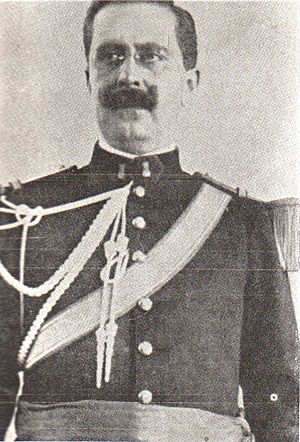Vito Alessio Robles facts for kids
Quick facts for kids
Vito Alessio Robles
José Vito Alessio Robles |
|
|---|---|

Robles c. 1917
|
|
| Deputy of the Congress of the Union for the 4th district of the Federal District |
|
| In office 1 September 1920 – 31 August 1922 |
|
| Preceded by | Paulino Fontes |
| Succeeded by | Rafael Pérez Taylor |
| Personal details | |
| Born |
Vito Alessio Robles
August 14, 1879 Saltillo, Coahuila |
| Died | June 11, 1957 (aged 77) Mexico |
| Spouse | Espinosa Como Cuevas Trinidad |
| Children | 7 |
| Parents | Dominic Alessio Bello (father) Crisanta Robles Rivas (mother) |
General Vito Alessio Robles (August 14, 1879 – June 11, 1957) was an important Mexican figure. He was a military officer, engineer, writer, journalist, and diplomat. He also taught at universities.
Vito Alessio Robles took part in the Mexican Revolution. He became one of Mexico's top historians. He was also a politician, serving as a senator. He was known for speaking his mind honestly. He is seen as one of the first "romantic revolutionaries" of Mexico. These were people who dreamed of and worked for a better future for all Mexicans.
Contents
Early Life and Education
Vito Alessio Robles was born in 1879 in Saltillo, Coahuila, Mexico. He was the oldest of seven sons. His father, Dominic Alessio Bello, was a merchant from Italy. His mother was Crisanta Robles Rivas. Two of his brothers, José Alessio Robles and Miguel Alessio Robles, also became military generals.
He studied at the Ateneo Fuente school. In 1896, he joined the Heroic Military Academy. He studied engineering there and graduated in 1903. He became a lieutenant in the Corps of Engineers. He also taught at the academy. He served the army loyally in different parts of Mexico. He met his future wife, Espinosa Como Cuevas Trinidad, in Sonora. They married in 1906 and had four children. His daughter, Ángela Alessio Robles y Cuevas, became an early woman engineer.
Military and Public Service
After finishing his studies, Vito Alessio Robles worked on many building projects for the army. He helped build military bases and a national dockyard in Sonora. From 1905 to 1908, he was involved in military operations against the Yaqui Indians.
In 1908, he became a Professor of Communications at the Military School. He later served as chief of staff for General Manuel Gordillo. From 1912 to 1913, he was a Military Attaché in Rome, Italy. He left the army because he disagreed with the government of Victoriano Huerta. He then joined the revolutionary movement led by Francisco I. Madero.
From 1915, Alessio Robles was the Governor of the Mexican Federal District for one year.
Political and Diplomatic Career
After 1920, he became a deputy for the Federal District. In 1922, he became a senator for Coahuila. As a senator, he was a strong and direct speaker. During this time, he was also appointed as a Minister to Sweden. After returning from Sweden, he became a Technical Advisor for the Ministry of Agriculture.
In 1927 and 1928, he ran for Governor of Coahuila but did not win. He then went to the United States and worked in Austin, Texas. While there, he studied many historical documents at the University of Texas at Austin. This helped him gather information for his future history books.
Historian and Writer
When he returned to Mexico, Vito Alessio Robles became a professor. He taught at the National Preparatory School and the Faculty of Arts in Mexico City. He also helped start the Seminary of Mexican Culture. As a founding member, he traveled to many places on cultural missions.
In 1937, he became a member of the Academia Mexicana de la Historia (Mexican Academy of History). From 1947 to 1950, he taught history at the Faculty of Philosophy and Letters.
His career as a journalist began in 1927 with the newspaper "El Universal." His first book was "Bibliography of Coahuila," which covered history and geography. He wrote many other history books. His three-volume work, "History of Coahuila y Texas," is a very important and detailed history of Texas.
Vito Alessio Robles had a huge collection of 14,000 books from the 17th to 19th centuries. This collection is now in a museum named "Centro Cultural Vito Alessio Robles" in Saltillo. Some of his other famous books include "Saltillo, en la Historia y en la Leyenda" and "Coahuila y Texas, desde la consumación de la independencia hasta el tratado de paz de Guadalupe Hidalgo."
Vito Alessio Robles passed away in Mexico City on June 11, 1957, at the age of 78. His daughter Angela inherited his large library.
See also
 In Spanish: Vito Alessio Robles para niños
In Spanish: Vito Alessio Robles para niños
- List of people on stamps of Mexico
- List of heads of government of the Mexican Federal District

